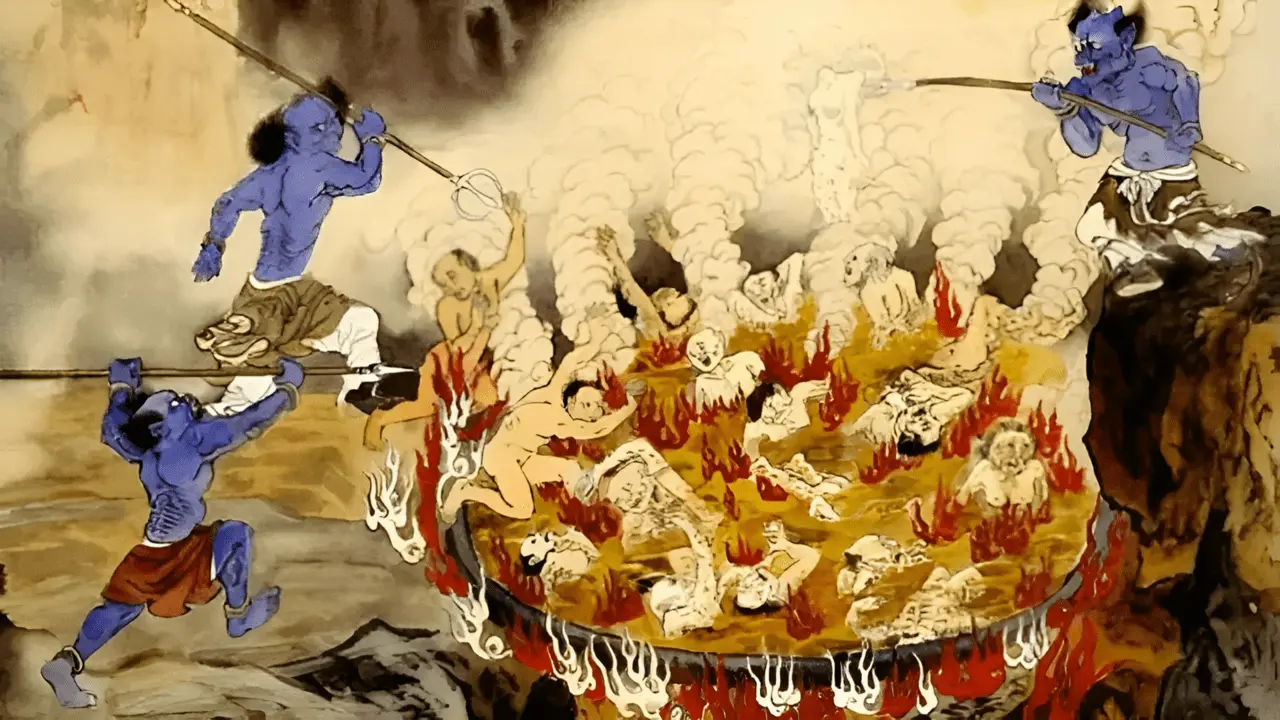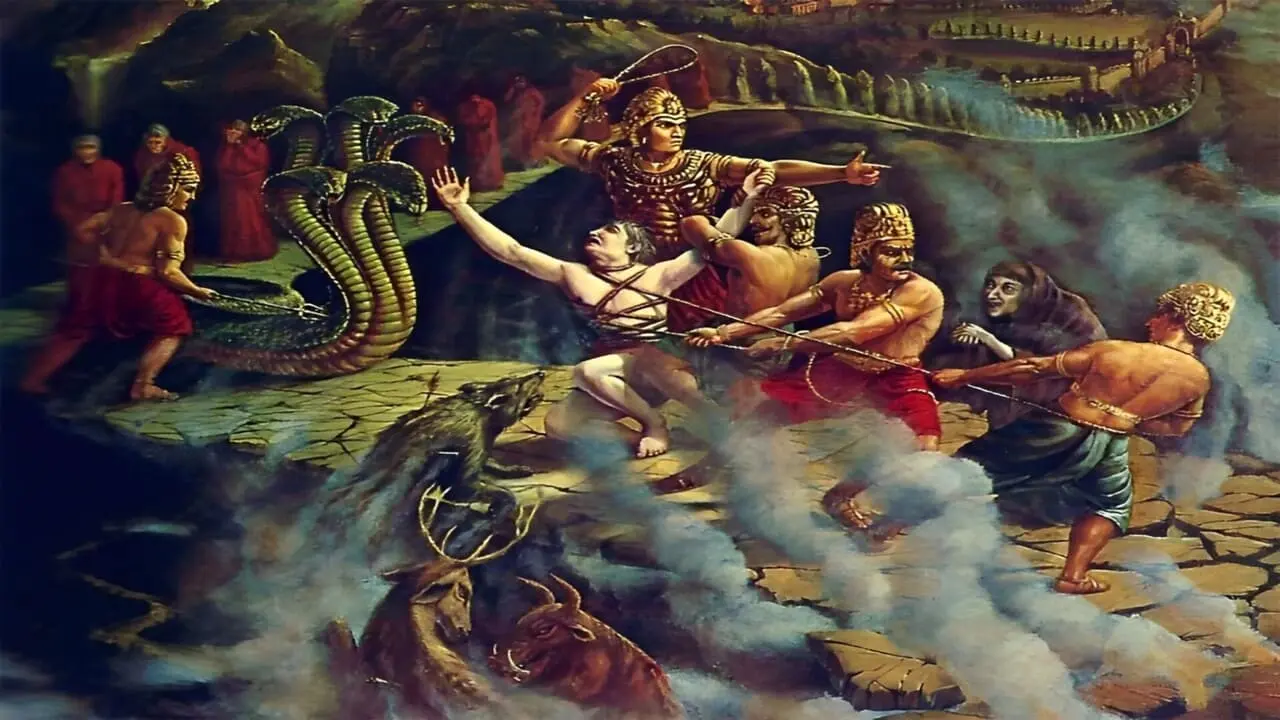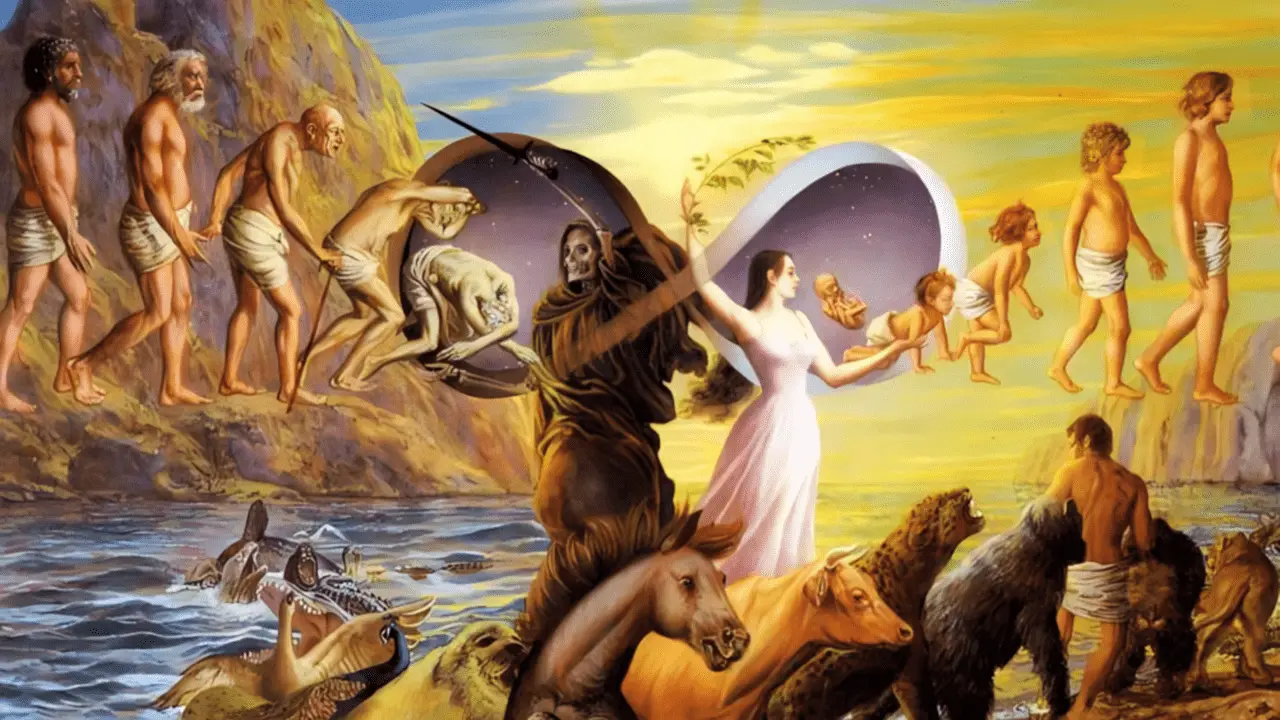In the vast tapestry of Hindu religious texts, the Garuda Purana stands out as a fascinating and complex scripture. Among its many subjects, one of the most intriguing is its detailed description of the afterlife, including the concept of Naraka, or Hell. According to the punishments in Garuda Purana there are 28 hells, each designed to punish souls for specific sins committed during their lifetime. Let’s embark on a journey through these realms of torment and introspect on the moral lessons they convey. Explore the vivid descriptions of punishments in garuda purana and delve into the intricate nuances of karma and retribution.
Yama’s Servants bind individuals who engage in wealth theft with ropes and consign them to Naraka, specifically Tamisram. In this realm, they undergo relentless thrashing until they faint from bleeding. The beatings persist upon regaining consciousness, continuing until their allotted time is fulfilled.
Those who wrongfully seize and derive pleasure from another person’s possessions or resources are cast into the inferno of Rauravam. Deceived individuals take on the form of “Ruru,” fearsome serpents, inflicting severe torment until their designated time in the hell concludes.
Plunderers or thieves of gold and jewels find themselves cast into the furnaces of Taptamurti Naraka, where unending, blazing fire keeps the heat relentless and intense.
False witnesses and oath swearers are designated for Avici Naraka, where they are hurled from great heights, utterly crushed upon impact with the ground. Subsequently revived, the cycle of punishment repeats until the conclusion of their allotted time.
Those who deceive others through treachery are condemned to Sulaprotam Naraka, impaled on tridents and compelled to endure the excruciating position. The suffering includes intense hunger and thirst, enduring all inflicted tortures throughout their designated term.
Spouses who only treat their partners well for personal gain or pleasure face the punishment of Andhatamisra Naraka, experiencing excruciating pain as they collapse senseless from tightly bound beatings similar to Tamisram.
This Naraka is designed for individuals, both men and women, who have engaged in adultery. A red-hot figure made of iron is positioned there, and the sinner is forced to embrace it, enduring the intense heat, while Yama’s servants flog the victim behind.
This hell is designated for rapists and for adulterers, making it the most dreadful place of punishment. It takes the form of a river filled with a repulsive mixture of human excreta, blood, hair, bones, nails, flesh, and various other filthy substances. Additionally, numerous terrifying beasts inhabit this hell. Those cast into it are relentlessly attacked and mauled by these creatures from all directions. Sinners must endure their punishment term by feeding upon the contents of this foul river.
This pit is filled with excreta, urine, blood, and phlegm. Men who engage in intercourse and deceive women without any intention of marriage are likened to animals. Those who roam irresponsibly, behaving like animals, are cast into this well to become contaminated by its contents. They must remain here until their allotted time is completed.
This Naraka is the punishment designated for sinners who engage in unnatural intercourse with animals. Within this realm, they are compelled to embrace iron piller filled with sharp diamond needles that pierce through their bodies. It is one of the fiercest punishments in Garuda Purana.
This Naraka is reserved for lustful men, specifically those who commit a particular act of depravity. Men who force their wives to swallow their semen are condemned to this hell. Lalabhaksam is described as a sea of semen, and the sinner is submerged in it, feeding exclusively on semen until their punishment term concludes.
Individuals who consume alcohol and other intoxicating beverages are sent to this Naraka. Women are compelled to drink melted iron in liquid form, while men are forced to consume hot liquid molten lava for each instance of alcohol consumption in their earthly lives.
This Naraka is designed for the torment of affluent individuals who disdain the poor and indulge in excessive spending merely to showcase their wealth and splendor. They must endure their entire term of punishment here, subjected to relentless battering from heavy clubs wielded by Yama’s servants.
This hell is the destination for braggarts and those who insult virtuous people. Yama’s servants subject the sinners to various forms of torture while keeping them upside down.
This hell is reserved for proud and miserly individuals who refuse to spend money, even for essential needs like better food or providing for their relatives or friends. Those who fail to repay borrowed money will also be cast into this realm. Here, their bodies will be incessantly pricked and pierced by needles.
Those who deny food to a hungry person and mistreat them are cast into this Naraka. Upon arrival, the sinners’ eyes are immediately pierced by the beaks of birds like crows and eagles. Throughout their punishment, these birds continue to pierce them repeatedly until the end of their sentence.
This hell is reserved for those who neglect their own duties. Yama’s Servants administer floggings using whips made of asipatra (sharp-edged sword-shaped leaves). If the sinners attempt to evade the lashes, they stumble over stones and thorns, falling on their faces. Subsequently, they are stabbed with knives until they lose consciousness. Upon regaining consciousness, the cycle repeats until the completion of their time in this Naraka.
This hell is characterized by intense heat. It is designated for those who disrespect their elders, especially when the elders have fulfilled their duties. Here, the sinners are compelled to run around in the unbearable heat, periodically collapsing from exhaustion.
This hell is the punishment for rulers who neglect their responsibilities and oppress their subjects through misrule. They endure being crushed to a pulp under heavy beatings. Punishments in Garuda Purana describe this process, which is repeated until their allotted time in this hell is completed.
According to punishments in Garuda Purana, it is one of the fiercest hells. This hell is reserved for those who oppress good people and refuse to help them despite having the resources to do so. They are thrown into a well inhabited by fierce beasts such as lions, tigers, eagles, as well as venomous creatures like snakes and scorpions. The sinners must endure the relentless attacks of these creatures until the end of their punishment period.
Sinners who treat others cruelly, resembling animals in their behavior, will be consigned to this hell. In this realm, numerous ferocious beasts await, and the sinners will be devoured alive by these creatures.
Those who commit unsocial acts such as poisoning food, mass slaughter, and ruining the country are sent to this hell. The only sustenance available here is the flesh of dogs. In this Naraka, thousands of dogs relentlessly attack the sinners, tearing their flesh from their bodies with their teeth.
This hell is designated for those who kill animals for pleasure. Massive vessels containing boiling oil await the sinners, who are then plunged into this scalding liquid as part of their punishment.
This Naraka is intended for those who keep dogs and other vicious animals, constantly hunting and killing animals for food. In this hell, the servants of Yama gather around the sinners, cutting them limb from limb while subjecting them to constant insults.
This hell is reserved for those who engage in animal and human sacrifices, consuming the flesh after the ritual. All the living beings they killed before gather here, joining forces to attack, bite, and maul the sinners. Despite their cries and complaints, there is no reprieve in this relentless and punishing realm.
This hell is reserved for those who persecute animals living in forests, mountain peaks, and trees. Once thrown into this hell, sinners are subjected to torture with acid, flames, and various weapons throughout their time here in this Naraka.
The vivid descriptions of Naraka and Punishments in Garuda Purana not only serve as cautionary tales but also as moral teachings, aligning punishment severity with sins committed. Illustrating belief in karmic retribution and consequences, these narratives emphasize the importance of a righteous life, kindness, and moral values. Despite gruesome details, they remind us of the consequences of wrongdoing and the need for virtue. Naraka serves as a tool for reflection, encouraging spiritual growth and striving for righteousness and compassion.





